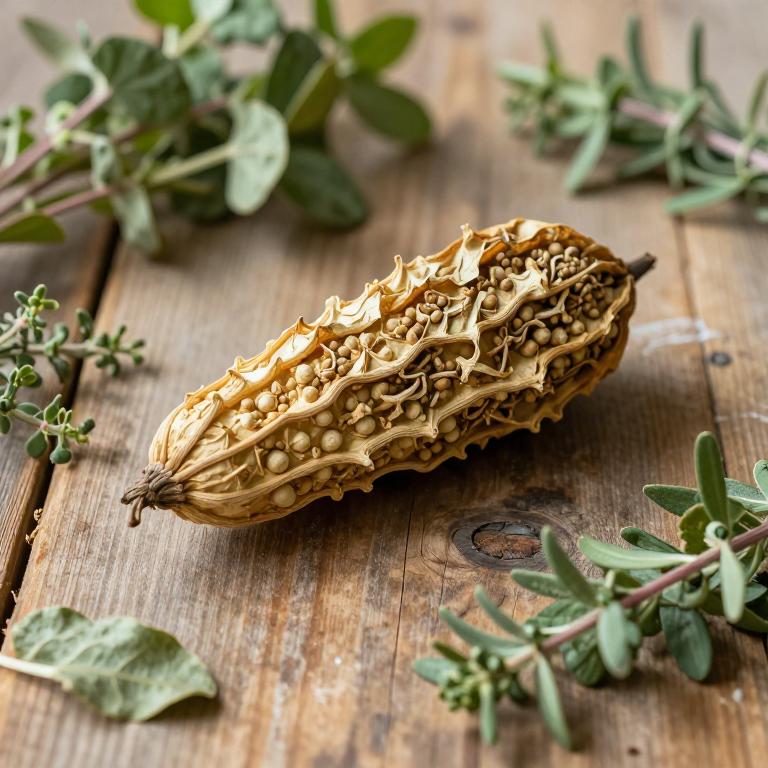Pumpkin (Cucurbita Pepo)
Information Reliability Score: 5/10
This score reflects the overall reliability of the information presented in this article. It is based on the quality of scientific evidence, accuracy of sources, and the transparency of references related to Cucurbita pepo.

Pumpkin, scientifically known as Cucurbita pepo, is a versatile vegetable commonly used in both culinary and medicinal contexts.
It is recognized as a medicinal herb with adaptogenic properties, offering a range of health benefits due to its rich nutritional profile. Traditionally, pumpkin has been used in various cultures for its ability to support digestion, reduce inflammation, and boost immunity, with historical records showing its use in Ayurvedic and Native American medicine. In modern wellness, pumpkin is valued for its high content of beta-carotene, fiber, and antioxidants, which contribute to skin health, eye protection, and cardiovascular support.
One unique feature of pumpkin is its distinctive sweet and earthy flavor, along with the presence of a rare compound called cucurbitacin, which has shown potential in supporting immune function and metabolic health.
FREE CHECKLIST
The Only 10 Herbs You Need to Heal 90% of Common Ailments.

Table of Contents
Scientific and Botanical Profile
Pumpkin, with botanical name Cucurbita pepo, is a member of the Cucurbitaceae family, commonly known as the gourd family, and is native to Central America, Mexico, and parts of North and South America, including the Caribbean, United States, West Indies, and Southwestern United States.
This versatile plant includes several varieties such as Acorn Squash, Zucchini, Buttercup Squash, Spaghetti Squash, Pattypan, and Cucurbita Pepo, which are all botanically classified under the same species. Morphologically, the pumpkin plant features a trailing vine with palmately lobed leaves, and its fruit can vary in shape, size, and color, ranging from round and orange to elongated and yellow. The fruit is typically harvested when mature, with a thick, smooth rind and a fleshy interior that is rich in nutrients and used in a variety of culinary applications.
This species has been cultivated for thousands of years and remains a staple in global agriculture and cuisine.
History and Cultural Relevance
Pumpkin was used by ancient civilizations such as the Aztecs, Egyptians, and Native Americans for food, medicine, and ceremonial purposes.
In traditional medicine systems like Ayurveda and Chinese herbalism, pumpkin has been valued for its high nutrient content and digestive benefits, with its seeds and pulp used to treat ailments such as inflammation and respiratory issues. Across various cultures, pumpkins have played a central role in harvest festivals, such as the Japanese "Kabukicho" celebrations and the Native American "Thanksgiving" harvest rituals, symbolizing abundance and gratitude. In modern times, pumpkin remains a staple in traditional remedies, with pumpkin seed oil still used to support prostate health and pumpkin puree being a natural remedy for constipation and skin conditions.
Its enduring cultural and medicinal significance highlights its deep-rooted place in human history and daily life.
Chemical Composition and Nutritional Profile
Pumpkin contains a variety of bioactive compounds and nutrients that contribute to its health benefits, including alkaloids, flavonoids, essential oils, and terpenes, which may have anti-inflammatory and antioxidant properties.
It is rich in vitamins such as A, C, and E, along with B-complex vitamins, and minerals like potassium, magnesium, and iron, making it a nutrient-dense food. The high levels of beta-carotene and other carotenoids act as powerful antioxidants, helping to neutralize free radicals and reduce oxidative stress in the body. These compounds support immune function, skin health, and may even have potential anti-cancer effects.
Overall, the combination of its chemical composition and nutritional profile makes pumpkin a beneficial addition to a balanced diet, promoting overall well-being through various physiological mechanisms.
Medicinal Properties and Health Benefits
Cucurbita pepo has been widely recognized for its diverse medicinal properties and health benefits, particularly in supporting the digestive, respiratory, and immune systems.
It is rich in vitamins, minerals, and antioxidants, which help reduce inflammation and enhance immune function. The plant's seeds and oils are known to promote healthy digestion by stimulating bile production and aiding in the elimination of toxins from the body. Compared to similar herbs like echinacea or garlic, cucurbita pepo offers a more holistic approach by addressing multiple systems simultaneously, with its high nutrient density providing a broader range of benefits.
Its unique advantages include a higher potency in certain anti-inflammatory compounds, making it a valuable natural remedy for chronic conditions such as arthritis and digestive disorders.
Discover the 10 best health benefits of Pumpkin.
Forms, Preparation and Usage
Cucurbita pepo has a variety of forms including fresh fruit, dried tincture, powder, essential oil, and capsule, each offering different therapeutic applications.
It can be prepared as a tea by steeping dried seeds or fruit in hot water, or as a decoction by boiling the tougher parts for a longer period. Topical applications include using the oil or powder to treat skin conditions, while an infusion may be made from the leaves for respiratory support. The recommended dosage for adults is typically 1-2 grams of powder or 1-2 capsules per day, while children should only use it under medical supervision if deemed safe.
Due to its potency, it is advised to use cucurbita pepo sparingly, with a short duration of treatment to avoid potential side effects.
Safety, Side Effects and Contraindications
Cucurbita pepo can be used in various traditional and herbal remedies, but its safety profile requires careful consideration.
While generally considered safe in moderate amounts, it may cause gastrointestinal side effects such as nausea, vomiting, and diarrhea in some individuals. It is important to note that high doses or prolonged use may lead to more severe adverse effects, including liver toxicity and allergic reactions. Cucurbita pepo may interact with certain medications, particularly those affecting the liver or blood clotting, so it should be used cautiously alongside prescription drugs or other herbs. Special populations, such as pregnant or breastfeeding women, should avoid using cucurbita pepo due to potential risks to fetal or infant development, and individuals with chronic illnesses should consult a healthcare provider before use.
To ensure safe use, always start with a small dose, monitor for adverse reactions, and seek professional guidance when incorporating this plant into a health regimen.
Growing, Harvesting and Storage
Cucurbita pepo grows best in well-drained, fertile soil with a pH between 6.
0 and 7. 5, requiring full sun exposure and consistent moisture. It thrives in warm climates with temperatures above 20°C, needing regular watering to maintain soil moisture without causing waterlogging. To ensure healthy growth, it is important to provide support for the vines, such as trellises or stakes, and to mulch around the base to retain moisture and suppress weeds. Harvesting should occur when the fruit is fully mature, typically 50 to 70 days after planting, by gently twisting or cutting the stem to avoid damaging the plant.
For optimal potency, the harvested fruit should be dried in a well-ventilated area, then stored in airtight containers in a cool, dark place or refrigerated to preserve its medicinal properties.